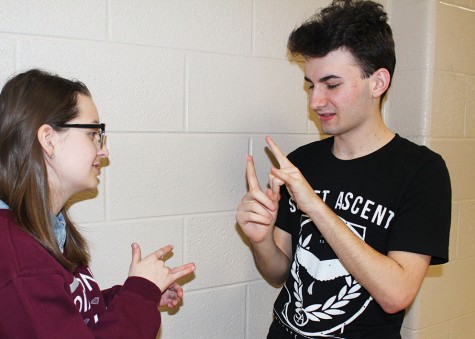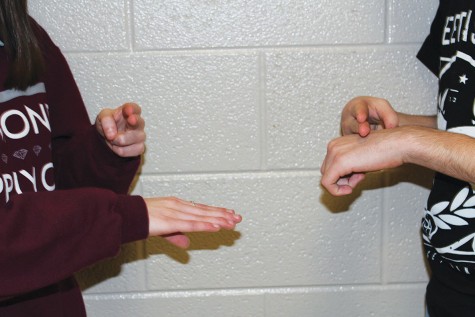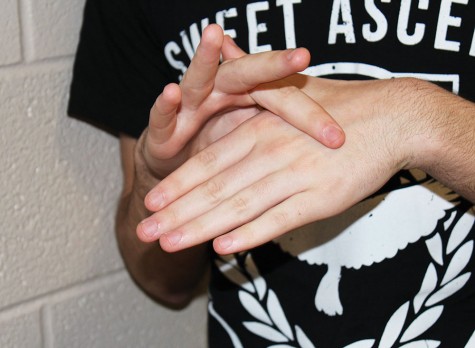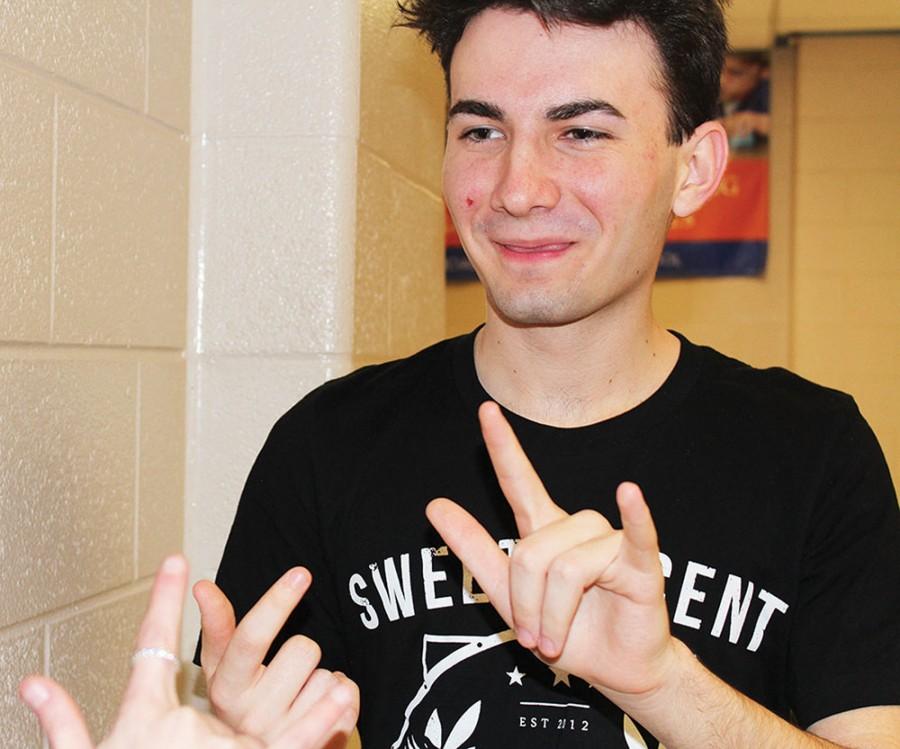The sound of silence
Photo by Photo by M. Thomas
Sophomore Alec Lefors teaches sophomore Madalyn Judah how to sign ‘I love you’. The two have been good friends since summer of 2015
February 10, 2016
For most, busy morning sounds tend to be the most routine part of the day. Most students are welcomed by the screech of an alarm clock or the irritated shout of a parent. They walk to their kitchens, waiting for the toaster to ding or the microwave to beep. They push their headphones in as the music drowns the world out. The sound of cars driving by and the bus’s deep roar in the distance let those with their eyes plastered to their cellphone screens know when to cross the street or if they need to sprint outside to the bus stop.
It is our ears that save us from being late to school or even from a reckless driver, so what happens if you can’t hear the alarm clock, the microwave, the music, the bus or the cars? For Sophomore Alec Lefors, the absence of sound is a substantial part of his life. Although Lefors himself is not deaf, his parents and youngest sibling are.
When sound is lacking in one’s everyday life, naturally, a different kind of routine is adapted. Because of this, it is popular to think that the lives of the deaf community are polar opposites of our own.
“There are some differences, but most people think my home is quiet and that you don’t hear anything,” Lefors said. “Really, it’s the total opposite. We always have TV running which has the sound on. My youngest brother, who is deaf, yells and screams because he can’t hear himself. My mom screams at us all the time because she can’t hear herself either.”
Although the lives of deaf families are not so alien as commonly believed, there are still special necessities required in deaf households in order for them to be able to function in a predominantly hearing world.
“First thing in the morning, there is a vibrator under the bed that shakes my parents awake,” Lefors said. “It vibrates the bed when the alarm goes off. We also have a doorbell that flashes lights in the house. There’s something called video phone, we call it VP for short. That’s our landline, you just call people through that. If you want to call a hearing person it goes through a relay and that’s an interpreter on the other side who signs and then voices that out.”
Along with the physical aspect of how deafness affects the lives of people, there comes the trouble of stereotypes and identification.
“Yeah, there is always different treatment,” Lefors’ mother said. “They treat me like I’m a special needs person or if I was…mentally ill.”
It is not always easy to avoid offending people whose lifestyles are unfamiliar. There are a few rules to pay a mind to if one finds themselves in a conversation with a deaf person.
“Tap shoulders softly, don’t hit or push a deaf person to get their attention,” Lefors’ mother said. “Don’t cover your mouth. Some deaf people, like myself, can read lips.”
Despite the fact that Lefors is not deaf himself, he has had his own share of obstacles.
“I think it has affected who I am because growing up as the oldest child I was put in the position where I would have to interpret for my family in most cases,” Lefors said. “Like, for example, when we would go to restaurants I would have to say what they wanted and give the orders and being put in that position I think it’s made me a natural leader. It puts a lot of pressure on me.”
Although Lefors’ situation is an unusual one, this does not mean his social life at home has to differ from any other students. Able-hearing sophomore Madalyn Judah is a close friend of Lefors and has been around Alec in both his home and at school.
“Alec doesn’t change,” Judah said. “He’s the same person around his family as he is around people at school.”
Deaf homes are no less understanding or unaware than hearing families. Albeit deaf families’ routines differ from our own, so do those of all families.
“I feel like even though you think that they would be less structured they actually have a lot of things and rules that they do in their own way,” Judah said. “Every family, whether they can hear or not, has a different way of doing things and they have their life figured out. They know what they are doing.”
Even though deaf families only remain unlike others in the fact that they are unable to hear sounds, this is the source of many hindrances that do not cross the minds of hearing people.
“It’s the in-the-moment things that cause the most trouble,” Lefors said. “Like not being able to hear police cars or sirens or fire drills.”
Although living with deaf family members has its ups and many downs, Lefors utilizes his unique situation to become more involved with other people and lives.
“If my family were hearing, I wouldn’t have gotten involved with a lot of deaf culture stuff,” Lefors said. “I’m a part of two worlds, and now I don’t know how I could go on without both of them.”

Sophomore Alec Lefors teaches sophomore Madalyn Judah how to sign ‘I love you’. The two have been good friends since the summer of sophomore year.

Lefors teaches Judah how to sign ‘hospital’ in American sign language. Lefors said that the way to sign hospital was different in his previous home of Louisiana compared to that of Indiana.

Sophomore Alec Lefors shows how to sign the word ‘meat’. Lefors explains that there are different ways to sign specific words from state to state.



